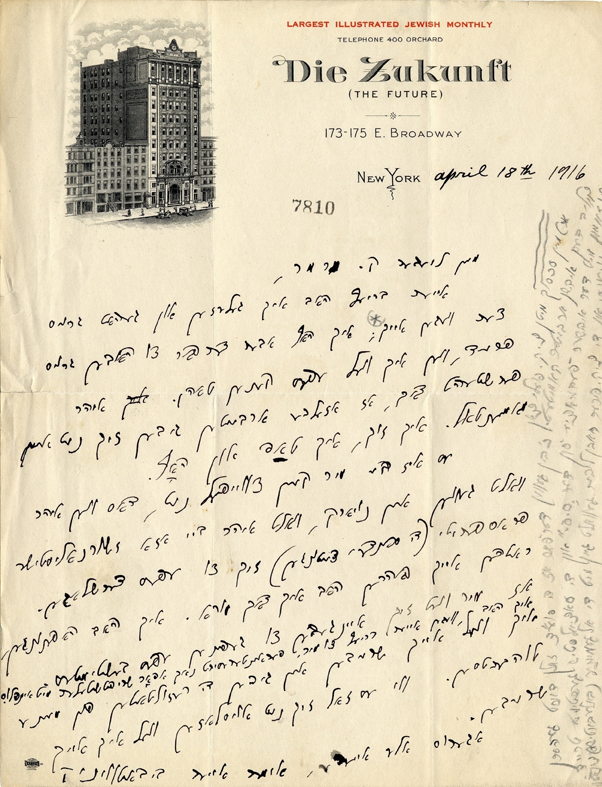Di gantse velt af a firmeblank: The World of Jewish Letterheads
Assemble the letterheads of Jewish organizations, institutions, and individuals in Europe, North and South America, and Palestine from the 1890s to the eve of World War II in 1939 and you have a portrait of the Jewish world: transnational; diverse in language, political, and religious orientation; and flourishing.
Di gantse velt af a firmeblank (The Whole World on a Letterhead) is an experiment in building that portrait. Here, we hope to bring you several times a month, a different example of letterhead from a single collection in the YIVO Archives, the Papers of Kalman Marmor.
Marmor, a Yiddish writer and cultural activist, was born October 11, 1879 in Mayshigola, Vilna Gubernia (today Maišiagala, Lithuania). In 1906, he settled in the U.S. Initially active with the Labor Zionist movement, he later became a Communist. He was an organizer of the 1937 World Yiddish Culture Congress, cultural director of the International Workers Order, and a contributor to the Communist Yiddish newspaper, Morgn Frayhayt. Between 1933 and 1936, he lived in Kiev, where he worked at the Institute of Jewish Proletarian Culture and prepared scholarly editions of the work of American Yiddish poets and writers. During Stalin’s Great Terror, the Institute was liquidated, and much of its leadership was arrested and executed. Marmor, an American citizen, returned to the U.S. He died in Los Angeles in 1956.
His papers at YIVO contain several thousand letters from the turn of the 20th century to the 1950s. He had an astonishingly diverse array of correspondents, not limited to Zionist and Communist activists.

From Berl Botwinik in New York to Kalman Marmor in Chicago, April 18, 1916. RG 205, Folder 96.
Berl Botwinik (1885-1945) was a Yiddish writer and a columnist for the Jewish Daily Forward, who immigrated to the United States from Russia in 1905, most likely in flight from persecution by the authorities for belonging to an anti-tsarist organization during the Russian Revolution of 1905.
He writes here on the stationery of Die Zukunft (Di tsukunft), a monthly founded in New York in 1892 as the organ of the Socialist Labor Party. It was acquired by the Forward Association in 1912, and this letterhead includes an illustration of the Forward Building at 173-175 East Broadway. It was one of the first serious Yiddish periodicals to be published anywhere and featured the work of many of the 20th century’s most prominent Yiddish writers. From 1940, it was published by CYCO (the Central Yiddish Cultural Organization). It continued to appear for over a century, only ceasing publication a few years ago.
From what Botwinik writes, it appears as if Marmor has become restless in Chicago. Botwinik assures him that prospects for journalistic work are much better in New York and says he will make inquiries on his behalf. In a penciled-in sidebar, he explains that his “quarrel” with the Poale Zion party in Chicago is that their leaders have chosen to ally themselves with the bourgeois general Zionist organizations inste ad of other socialist Jewish organizations.
Marmor, at that time the Chicago editor of the Jewish Daily Forward, was not to leave Chicago for New York for several more years. By 1920, he had totally repudiated his affiliation with Zionism and shifted his allegiance from the Socialist Party to the Communist Party. His radicalization led to his leaving his post with the Forward, and in 1921, he moved to New York.
Series curated by Roberta Newman; Images digitized by Vital Zajka. Biographical information on Kalman Marmor from biographical note by Daniel Soyer in the inventory to RG 205, Papers of Kalman Marmor.